LEE KIT: EVERY BREATH YOU TAKE
| May 10, 2013 | Post In LEAP 19

The use of everyday materials within the art museum or gallery in order to disrupt the symbolist power structures they harbor is a rebellious act common among conceptual artists, the target of such acts often being the obsessive materialism of developed consumerist societies. As Guy Debord declared penetratingly: “In societies where modern conditions of production prevail, all of life presents itself as an immense accumulation of spectacles. Everything that was directly lived has moved away into a representation.” Debord’s prophecy has long since become a very real plight of the present. Similarly, the political and extremist tendencies of conceptual art are gradually being watered down… so how should contemporary art now approach reality, overflowing as it is with grandiose spectacle and individualist desire?
In this exhibition, Hong Kong artist Lee Kit’s response to this problem is both delicate and subtle. Inside the white confines of Minsheng Art Museum, Lee has meticulously recreated scenes of a bathroom: on a white aluminum shelf are placed two blue plastic beakers; two colored drinking glasses are placed on the floor, facing a fluorescent strip light; on a few pieces of cardboard the logos of various sanitary products are lightly drawn; a white laundry basket lies on the floor, a blue hand towel dispenser on the wall, and around the corner in the exhibition hall proper, plastic basins of a soft green meet an arrangement of television screens showing a constant stream of imagery relating to skincare. The soft tints of every item found here exude the comfort and warmth of domestic life. Each stands silently and peacefully, so much so that when leaning against the wall and looking out, it is easy to miss the two bathmats that lie on the ground by your side. These, too, belong to Lee’s installation. In this fabricated environment within an art space, it seems as though the viewer is peeping in at an individual’s daily morning skincare ritual. This impression manifests itself silently, possessing a silent, womb-like atmosphere. In the chilly space of Minsheng, Lee’s bathroom spectacle appears as if shrouded in warm mist, allowing the body to find comfort in various familiar memories. This is Lee’s private narrative. Lee’s art and its dealings with daily life lie in the act of mulling over each fragment individually, and then, seemingly unconsciously, placing it back into life itself. To Lee, life need not be clamorous; days pass by one by one, in little fragments.
The scenery of Hong Kong, its hyper-materialist society and rapid-speed daily rhythms are perhaps not particularly conducive to poetry… after trips to the mall and fine restaurants have exhausted both desire and the wallet, the remainder of life, for the ordinary citizen, takes place on the sofa in front of the TV. If art can engender introspection, self-realization, in the effortless rediscovery of something simple and beautiful: shadows cast across a wall by a curtain moving in light breeze, coffee and jam stains on a breakfast table cloth, a green bottle of skin lightening powder resting by a white wall, waiting to be either used or forgotten about, the familiar smell of moisturizer evoking memories of years passed… American poet William Carlos Williams’s most famous verse, titled Red Wheelbarrow, expresses well the richness of the simplest of life scenarios:
So much depends upon
a red wheelbarrow
glazed with rainwater
beside the white chickens.
Lee Kit uses everyday materials that relate to our lives, familiar smells that linger in our memory. He creates atmospheres about longing, absence, about the pursuit of comfort, which penetrate into our hearts. If modern life has really already yielded to visual phenomena, then at least Lee brings to this great society of spectacle something microscopic, something delicate. Standing here, we ought to take one deep breath after another, and listen quietly and attentively to the sound of each one. (Translated by Dominik Salter Dvorak)


